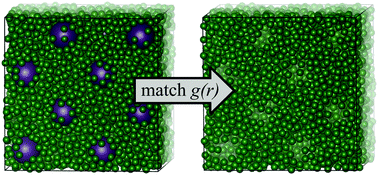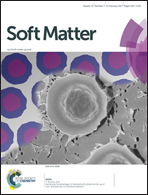Interactions and design rules for assembly of porous colloidal mesophases†
Abstract
Porous mesophases, where well-defined particle-depleted ‘void’ spaces are present within a particle-rich background fluid, can be self-assembled from colloidal particles interacting via isotropic pair interactions with competing attractions and repulsions. While such structures could be of wide interest for technological applications (e.g., filtration, catalysis, absorption, etc.), relatively few studies have investigated the interactions that lead to these morphologies and how they compare to those that produce other micro-phase-separated structures, such as clusters. In this work, we use inverse methods of statistical mechanics to design model isotropic pair potentials that form porous mesophases. We characterize the resulting porous structures, correlating features of the pair potential with the targeted pore size and the particle packing fraction. The former is primarily encoded by the amplitude and range of the repulsive barrier of the designed pair potential and the latter by the attractive well depth. We observe a trade-off with respect to the packing fraction of the targeted morphology: greater values support more spherical and monodisperse pores that themselves organize into periodic structures, while lower values yield more mobile pores that do not assemble into ordered structures but remain stable over a larger range of packing fraction. We conclude by commenting on the limitations of targeting a specific pore diameter within the present inverse design approach as well as by describing future directions to overcome these limitations.



 Please wait while we load your content...
Please wait while we load your content...